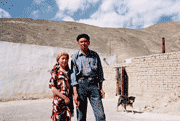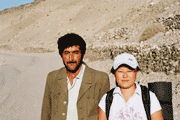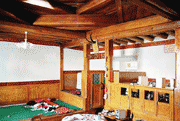| |
ON THIS SIDE OF PYANDJ
Preface
Chapter 1. THE KINKING WAY TO THE CAPITAL OF THE PAMIRS
Chapter 2. THE STORY REPEATS
Chapter 3. STRONGHOLDS OF THE WAKHAN VALLEY
Chapter 4. PAMIRIS AND BADAKHSHANIS
Chapter 5. AFGHAN BANK IS OF NO NEED TO YOU
Chapter 6. GOING HOME
CHAPTER 4. PAMIRIS AND BADAKHSHANIS

I was going to Gorno-Badakhshan with an intention to write about various peoples and various religions, comparing them and say who is better and who is worse. But in a few days I began to realize that mountains do not divide people by any features, making all the Pamiris the most hospitable and warm-hearted people on earth.
Naturally, the development of tourism in the region had already left its fatal consequences on some part of the population who try to solve their financial problems during the tourist season, or, what is worse, at the expense of a single traveler. But such people are generally exception to the rule, and I hope that even they would finally understand that tourists go to those places where they are treated as usual people but not as money-bags.
 |
Turat and his daughter Gulchakhra
|
Actually, the word ‘Pamiris’ can be applied to both nations living in the Pamirs on the whole, and those who have been living there since ancient times (ethnic Pamiris). The latter group includes the Rushanis, the Shughnis, the Wakhis, the Ishkashimis and a few other relatively small nations. Besides properly Pamiri peoples, there live a lot of Kyrgyz in the local mountains (in Murghab region in the Eastern Pamirs), and a number of Tajiks. Almost all ethnic Pamiris (excluding a part of Yazgulamis and Vanjis) are followers of Ismailism, one of the branches of Shiite Islam. The Kyrgyz, as well as the above mentioned Yazgulamis and Vanjis are Sunnite-Moslems. But on the whole, this region was always popular for the people’s tolerance and interpenetration of religions for during thousands of years this was a place where Zoroastrianism, Buddhism, Islam and Christianity met each other (and enriched at the same time).
Penetration of Ismailism to the Pamirs is associated with the name of the poet and philosopher Nasir Khusraw who lived and preached in the eleventh century. Since that time, most of the Pamiris confess Ismailism in which the features of their more ancient beliefs connected with fire worshiping can be traced. But despite Ismailism is a branch of Islam many Moslems living in the lowlands still keep on calling the people of Badakhshan, who obstinately do not want to be considered Tajiks and refer to themselves as Pamiris, only pagans and kyafirs (infidels).
Indeed, speaking about Gorno-Badakhshan, one cannot help concentrating on Ismailism because this rather liberal religion nowadays determines the life of the local people in many respects, as it was hundreds of years ago. It happened so that the Shiite branch of Islam, declaring the right of Ali’s descendants (prophet Mohammed’s son-in-law and cousin) to rule the Moslem community, survived generally in the territories where the population had confessed Zoroastrianism before. Shiism has been considered an Islam version of Protestantism, whereas Ismailism that separated from Shiism in the eighth century became ‘protest against protest’. It was then when the sixth Shiite imam Jafar conducting policy of concession towards the Sunnis, deprived his elder son Ismail of heirship, because of his disaccording views. Ismail died earlier than his father, and not his son but his small brother had been announced as imam. After that, a part of Shiites took the side of Ismail’s heirs and seceded from the chief commune. At present time there are about 20 millions of Ismailis throughout the world, over 150 thousands of them living in the Pamirs. Tajikistan Ismailis had been kept absolutely isolated from their brethren abroad for a long time (over 50 years). However, during this time the traditions were retained the same, as well as the ancient treatises of Ismaili theologians the number of finds of which makes Gorno-Badakhshan Autonomous region an indubitable record-holder at present.
Progressive nature of Ismailism was primarily based on the fact that this religion did not deny science. Quite the opposite, it tried to use all scientific achievements. Due to this reason, highly educated Ismailis could never be blamed for blind abidance of bookish dogmas. But they have been always accused of rather liberal interpretation of holy books and non-observance of most of obligatory traditional ceremonies.
Ismailis do not have clergy. There are only pirs (old men) and caliphas (deputies) appointed by the supreme spiritual leader – Aga Khan, and even they are not sure to be met everywhere. There are no mosques or prayer houses for any Pamiri house can be used for praying. Ismailis do not keep the fast (uraza) because they consider that their whole life passes like uraza and there is no necessity to constrain the organism in certain periods but to indulge in glut for the rest of time. Pamiri women never wore paranjas and always sat at one table with the men, and when meeting each other they shake hands and often exchange kisses.
Ismailis have no responsibility to do Khadj to Mecca. Anyone of them thinks it their duty to see alive Aga Khan instead. Aga Khan runs the commune through firmans (decrees) in which he gives an account of contemporary interpretation of the Koran, for Ismailis are well aware of the fact that life is not at a standstill but it changes, and together with it change the views of the world, of what is important and essential in it.
Even when preparing to go to Gorno-Badakhshan I often met mentioning of such a famous personality as Aga Khan IV. This man is now running Ismailis’ commune and is their so-called ‘imam of the time’. I should admit that before our trip I was rather skeptic to perceive information about him: mass media could write anything in an effort of propaganda. But having arrived at the place and communicated with the local people I realized that love for Aga Khan among Pamiri people is the rule. Indeed, how can one dislike the person whose efforts saved the people from starvation? This happened during the Civil War and economic blockade of the Pamirs in the first half of the 90-s when official Dushanbe literally left the huge Gorno-Badakhshan region without provision. Then Aga Khan sent caravans of humanitarian aid to Gorno-Badakhshan via Kyrgyzstan. And these caravans saved from famine hundreds of thousands of people. This fact Badakhshan’s people will remember for the rest of their life and, in my opinion, their descendants will remember it as well. Besides, they will remember not only Aga Khan’s aid but Dushanbe ’s treachery.
Liberality of Ismailism, which is based first of all on progressive views of Imam, and the support he gives to the population of Gorno-Badakhshan have formed the opinion of the majority of the people that he is a prophet at least, if not god. And, by the way, Ismailis will not conduct a long and tedious debate concerning Aga Khan’s true essence (as representatives of many other religions would constantly do, falling down to religious wars and splits sometimes), which is very important. Everyone understands Imam in his own way and has full authority to. And claims of willingness to give one’s life for Aga Khan are not such a rarity here, but rather a rule. So, the people call prince Karim just ‘our Imam’ or ‘our Aga Khan’, and somebody even prefers a more elevated wording, ‘His Highness’.
I am not a believer at all. And I do not tend to judge people by their words and those principles they proclaim. That is why I judge Aga Khan by his actions, and they undoubtedly bring the good. At present the fund founded by him is actively engaged in developing the economy of Gorno-Badakhshan, participates in various humanitarian projects, and improves medicine and education.
It is very interesting to listen to Gorno-Badakhshanis discourse on their present life. On the whole, if analyzing the moods of contemporary Pamiris, I can conclude that the old miss the time of the Soviet Union and the young dream of the goods of modern civilization.
 |
|
Connections with the ex-soviet republics are as strong and well-remembered here as nowhere else. During the Soviet period Pamiri people never served in army on their motherland. The existing policy threw them into the most difficult and responsible places: secret test sites, remote frontier posts and closed towns. The fidelity to Russia that was inherent in the people of these lands, was probably planned to be used to bring up real defenders of the southern borders. That is why it was more sorrowful for the local people to see Russian frontier guards leave the Pamirs in the autumn of 2004. With the bitterness the Pamiris observed how the Soviet Union was being destroyed, because in contrast to many other republics, Tajikistan ’s independence was of no benefit for them. Quite the opposite, being a very important strategic region in the USSR, Gorno-Badakhshan always had centralized support from Moscow. When the Union collapsed, villages were left to stay without electricity and foods rose in price.
During our whole trip we met a lot of people whose fates were associated both with Kazakhstan and Karaganda directly. Somebody served in the Army, other ones worked, some other people have relatives here. And, there is, perhaps, the most surprising fact all over the post-soviet space: only in the Pamirs when people know you are from Kazakhstan (or any other ex-soviet republic) they will be glad to see you and call you compatriot.
The young generation, as anywhere, wants everything new. They are attracted abroad by everything lacking in their native Gorno-Badakhshan: big cities, supermarkets, night clubs, sexual freedom. But despite this, they know and love their background and are proud of their past but have a stronger desire to go to future.
The girls (in my opinion, at least) are less liable to modern tendencies, though. Take clothes, for example. Actually, it is very interesting to observe how clothing styles are divided on the basis of sexual difference in Badakhshan. The interesting fact is that the local men very quickly stick to European style in clothes and it would be very difficult to see a man in a robe and loose oriental trousers. The majority of the men wear coats and trousers or jeans. But to see a girl in jeans will be really difficult. I think that it is due to men’s influence but women still prefer to wear old-style tunic-dresses with huge shoulder pads and loose trousers, and it does not matter where you see them: in a remote kishlak of the Wakhan Valley or in Khorog (only in the latter case the shoulder pads will be bigger).
 |
|
But what remains unchanged in Gorno-Badakhshan is people’s dwelling. There is a notion ‘Pamiri house’. A traditional Pamiri house (which is a majority in Gorno-Badakhshan) is built according to a typical scheme the whole of which is based upon commandments of Ismailism put on Zoroastrian traditions that have not been forgotten after a lapse of two millenniums. Chid (this is an example how a Shughni calls his house) is a combination of several obligatory elements, and everything here is impregnated with symbolism. Five invariable pillars each of which is associated either with Mohammed prophet’s family members (the so called the shiite five: Mohammed, Ali, Fatima, Hassan and Hussein) or with Zoroastrian gods. Number and place of the bars forming the ceiling are strictly regulated. There are three obligatory levels of floor, raising one above another at about half a meter and symbolizing one of the ‘kingdoms’ of nature. There is without fail the vaulted ceiling ‘chorkhona’ and Aga Khan’s picture in the place easily seen. And above the entrance in each Pamiri house there are horns of argali or ibex, the animals which have been considered sacred in the Pamirs since Zoroastrianism.
Earlier, and sometimes at present, any event in a Pamiri’s life was displayed inside the chid. For example, the cradle with a child is usually placed near Mohammed’s column which is to be made of juniper according to all canons (which is not always so in our days). Next to this column that is chief in all senses they are accustomed to initiate a boy to a man, when he puts on white men’s clothes on his fifteen’s birthday. During the wedding party the bride and fiance are sitting near Ali’s column (who is devoted, according to the Zoroastrian tradition, to the angel of love Mehr) in order to be blessed for long and happy life. Just before the wedding, when the bride is outing on her wedding dress, she stands next to the column of Fatima who was the prophet’s daughter and mother of Hassan and Hussein. The column of Hassan who did not have children, symbolizes the angel of Earth Zamyod in Zoroastrian tradition. Next to this column a noble guest or a religious leader (calipha) is usually seated. The column of Hussein, who became imam after Ali, is the place to hold various ceremonies including funeral, as well as nuptial and praying.
Otashdon or langar (the place to make a fire), as thousand-year Zoroastrian traditions of the Pamiris say, is an especially sacred place, a kind of altar, I would say. The hearth heats the house, is used in cooking, especially for baking flat cakes. There are also special cases when sacrificial incenses are kindled in it.
Perhaps, the most amazing and beautiful element in chid is its wooden vaulted ceiling called ‘chorkhona’. Chorkhona is installed in the center of the ceiling and consists of four square stages put down one into another. Each of the stages is believed to stand for definite element. The lowest stage is the dwelling of the Earth, the second symbolizes water, the third one is devoted to wind or air, and the highest and the smallest stage is for the house of Fire symbolizing the Sun. It is through this fourth stage that the sun light which is especially sacred for Zoroastrians penetrates into the house.
Under contemporary circumstances they often attach additional rooms, dais and various constructions to the classical rectangle chid. Still, it remains the nexus for the entire house, its heart and history-keeper.
Not in the last place it amazed me how well all local people know history of their land. Maybe, this should not be surprising for love for motherland was for most of people fortified with higher education (Gorno-Badakhshan was the leader in the USSR by the number of licensed specialists per head, and now studying sciences is encouraged even if this knowledge cannot be applied in practice). That is why you would be able to listen to stories about colonel Yonov’s marches and the Kushan Empire here in detail, if you had not been lucky to study the history of these places before your trip. Moreover, when you are sitting at hearty dastarkhan in a company of wonderful people, knowledge will be absorbed on its own, without any effort on your part. Just because everything around will be perceived as frozen history, so far in time and so close in space.
|



